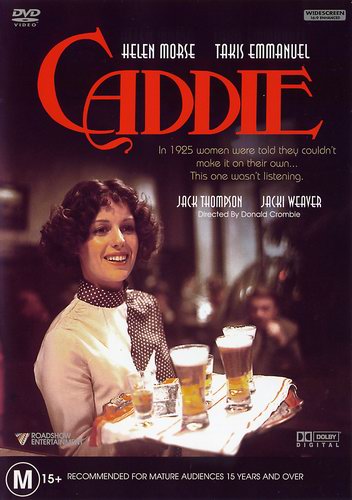Caddie (1976) |
|
Caddie (1976) |
|


|
| BUY IT |
| General | Extras | ||
| Category | Drama |
Main Menu Audio Scene Selection Anim & Audio Audio Commentary-Donald Crombie (Director) & Anthony Buckley (Producer) Filmographies-Cast & Crew Theatrical Trailer Notes-Caddie Files Featurette-Caddie On Location with Producer's Commentary |
|
| Rating |

|
||
| Year Of Production | 1976 | ||
| Running Time | 104:13 (Case: 106) | ||
| RSDL / Flipper | RSDL (71:01) | Cast & Crew | |
| Start Up | Menu | ||
| Region Coding | 4 | Directed By | Donald Crombie |
|
Studio
Distributor |
Australian Film Comm Roadshow Home Entertainment |
Starring |
Helen Morse Takis Emmanuel Jack Thompson Jacki Weaver Ron Blanchard Drew Forsythe |
| Case | Amaray-Transparent-Secure Clip | ||
| RPI | $24.95 | Music | Patrick Flynn |
| Video | Audio | ||
| Pan & Scan/Full Frame | None |
English Dolby Digital 2.0 (320Kb/s) English Audio Commentary Dolby Digital 2.0 (320Kb/s) |
|
| Widescreen Aspect Ratio | 1.85:1 | ||
| 16x9 Enhancement |
 |
||
| Video Format | 576i (PAL) | ||
| Original Aspect Ratio | 1.85:1 | Miscellaneous | |
| Jacket Pictures | No | ||
| Subtitles | English for the Hearing Impaired | Smoking | Yes |
| Annoying Product Placement | No | ||
| Action In or After Credits | No | ||
Caddie can legitimately claim to be among the movies that revitalised the Australian film industry. It was made around the same time as Picnic at Hanging Rock (when, oh, when is that going to be released in R4?). It earned four AFI awards (although two of them were a tie for Best Supporting Actress between two of the actresses in this film). When it was released it ran for 54 weeks on a single screen, a record run for an Australian film
This is not a particularly easy film to describe. It is an account of a few periods in the life of a woman who lived in Sydney, whose autobiography Caddie — the autobiography of a Sydney barmaid, was published in 1953. It has recently come to light that the woman was Catherine Elliot-Mackay, known as Caddie after a customer described her as being as classy as his new Cadillac.
The film starts with her leaving the house of her husband after he admits his adultery with her friend Esther. Against her husband's wishes, she takes their two children, Terry and Ann, with her. She has no money, no training, and no relatives to depend on. It is up to her to make a living to support herself and the children, and that is far from easy for a single mother in Sydney in 1925. She tries for a job as a waitress, the only thing she has any experience at, but ends up taking a job as a barmaid (this is rather a come-down from waitress), because it is all that is available. She, and her children, go through good times and bad, including the Depression.
Some younger folk may have trouble understanding some of the things that happen in the film, because little is taught in schools about what life was like in Australia in the early part of the twentieth century. They may find it hard to understand a society that offered nothing much in the way of social welfare and that treated women as second class citizens (they were supposed to stay at home and be supported by their husbands). They may not realise that woman were paid far less than men (women weren't supposed to be supporting a family). I heard about some of this from my grandmother, but she didn't much like to talk about it — that's easy to understand. This film helps one appreciate how much things have changed.
Helen Morse's performance is truly wonderful, and she makes it look so easy. There are some marvellous supporting performances, from actors like Jacki Weaver, Ron Blanchard, and Jack Thompson. And there are some delightful cameos, such as June Salter and John Ewart, for example, and even Robyn Nevin (now Artistic Director of the Sydney Theatre Company) as a black-eyed prostitute. The commentary points out a great many known actors and comedians in tiny roles — you could never assemble a cast like this today, but this was made when there were very few feature films made in Australia.
This film has moments of sadness, and not a lot of joy, but it cannot be dismissed as a simple "weepy". It's an interesting story about life in Australia between the two World Wars, during times when life was difficult, but people could still find some happiness.
The DVD is presented in an aspect ratio of 1.78:1. It is 16x9 enhanced. The original and intended aspect ratio is 1.85:1.
The image is soft, but clear enough to enjoy. Shadow detail is limited, with darker spots dropping off into black much too quickly. Film grain is not particularly noticeable. There's no low-level noise.
Colour is a bit restricted, but that's mostly attributable to the authentic palette used in the production design. This DVD suffers badly from an over-bright transfer. Whites are quite over-blown, and halo throughout. Skies are usually white rather than blue. Windows are horribly over-hot white — have a look at 32:28 for an example. Almost anything illuminated by sunshine is far too bright. All up, exteriors look almost pastel.
There are lots of film artefacts, mostly tiny spots and flecks, but also occasional larger flecks. There's a major scratch patch on a frame at 45:39. There's a hole burnt in a frame at 54:04. There are reel change markings in the top right corner (see 19:10 , 55:46, and 94:20, for example), making it obvious that this transfer was taken from a display print, and not one in fabulous condition, either. There are several examples of slight telecine bounce (see between 29:15 and 29:21 for examples) — possibly due to damage to the film sprocket holes.
There is not a lot of aliasing, but it is probably masked by the general softness of the transfer. There are examples of moire, but they're minor. There's minor shimmer. There are no MPEG artefacts.
There are subtitles in English, but that's all. They are Hearing Impaired subtitles, but they don't include a lot of sound effects. They are not perfectly timed, sometimes appearing a little later than the dialogue. There are several cases (at least four) where the subtitles have been typed with a space missing between words. Other than that, they are easy enough to read.
The disc is single-sided and dual-layered, formatted RSDL. The layer change comes at 71:01, and is really nicely placed on a still title.
| Sharpness | |
| Shadow Detail | |
| Colour | |
| Grain/Pixelization | |
| Film-To-Video Artefacts | |
| Film Artefacts | |
| Overall |
There are two soundtracks on this disc: the film's soundtrack, and the commentary, both in Dolby Digital 2.0. I listened to both of them. There is some very minor hiss and crackle at points in the soundtracks, betraying the analogue tape recording used.
The dialogue is clear and readily comprehended. There are no major audio sync issues, but there's a minor misalignment around 32:35.
The score, from Patrick Flynn, is nicely judged. It sounds like music of the era, which is the effect the director was looking for.
The surrounds and subwoofer are not given anything to do, but that's no problem — there's no call for them in this movie.
| Dialogue | |
| Audio Sync | |
| Clicks/Pops/Dropouts | |
| Surround Channel Use | |
| Subwoofer | |
| Overall |
The menu is static with a short piece of music behind it. It is easy to use.
The commentary is provided by the director, Donald Crombie, and producer, Tony Buckley. It is interesting and surprisingly informative considering they were recording it 25 years after making the film. Perhaps the fact that it was their first feature film accounts for their clear memories of it. Strongly recommended.
This is the longest listing I've seen on a DVD — the list of cast and crew runs seven pages, and there are filmographies supplied for fourteen of the people (most are just 2 or 3 pages, but a couple go on for 5 pages). It's quite impressive to see some of the films that the crew have worked on since: the DP worked on Driving Miss Daisy, for example, while the camera operator has since been cinematographer on Harry Potter and the Philosopher's Stone, Dead Poets Society, and Rain Man, among many others.
A decent trailer, with voice-over from Jack Thompson.
This is a menu full of interesting snippets. One of the nicest is the Director's Working Script, which has links to three scenes from the film. Included here are:
This is far from the usual glossy effort produced today. This is home movie footage shot by one of the crew showing what being on location was really like in 1975. The footage is silent, but there's a really interesting commentary from producer Tony Buckley. The commentary is a bit loud and distorted, but listen carefully, because he has a lot to say.
There is censorship information available for this title. Click here to read it (a new window will open). WARNING: Often these entries contain MAJOR plot spoilers.
NOTE: To view non-R4 releases, your equipment needs to be multi-zone compatible and usually also NTSC compatible.
This film is not yet available on DVD in any other region.
Caddie is an Australian classic, finally on DVD.
The video quality is not good, but may be the best we can get without a huge restoration effort.
The audio quality is adequate.
The extras are very interesting, and quite impressive for a film of this age.
| Video | |
| Audio | |
| Extras | |
| Plot | |
| Overall |
| Review Equipment | |
| DVD | Pioneer DV-S733A, using Component output |
| Display | Sony VPH-G70 CRT Projector, QuadScan Elite scaler (Tripler), ScreenTechnics 110. Calibrated with Video Essentials. This display device is 16x9 capable. |
| Audio Decoder | Built in to amplifier/receiver. Calibrated with Video Essentials. |
| Amplification | Denon AVC-A1SE |
| Speakers | Front Left, Centre, Right: Krix Euphonix; Rears: Krix KDX-M; Subwoofer: Krix Seismix 5 |